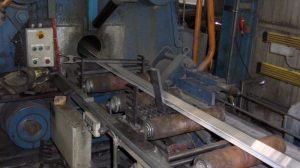Machine safety
The Machinery Directive 2006/42/EC and the (german) Ordinance on Industrial Safety and Health (BetrSichV 2015) are of particular importance for “machinery, mechanical engineering and industrial plants” in the EC and Germany.

Safety of machines and their operation
The Machinery Directive regulates the placing of machinery on the market in the European Economic Area (EEA). Its aim is to harmonize, maintain or improve the level of safety and essential safety requirements for machinery in the member states.
Overview
Machine safety
Safety of machines must be taken into account during manufacture and development and must also be ensured during operation. Essential are:
- Machinery Directive 2006/42/EC and its “predecessors” 98/37/EC and 89/392/EEC ,
- Industrial Safety Ordinance “BetrSichV 2015”
Machinery Directive
The European legislator does not prescribe “how” the conditions of the Machinery Directive are met. However, it requires the industry “that” it meets and realizes the targets in the product. With regard to the accumulated experience, two thirds of the machines in the European Economic Area do not meet the conditions for placing on the market. Sanctions are a consequence if deviations are found.
Violations of the Machinery Directive and possible consequences
Many machine manufacturers are careless with the requirements of the Machinery Directive and “take care” of the formal requirements, such as the risk assessment “as an afterthought” instead of in parallel with the development.
If the Machinery Directive is not complied with, the machine is legally unacceptable. In this case, the market supervisor will initially prevent the sale of goods. If personal injuries have occurred, civil and / or criminal proceedings are the consequence. This usually entails high costs and – economically much more significant – a negative image.
In case of violations threaten
- Civil actions,
- criminal investigations/proceedings under public law against responsible persons(directors, managers, developers),
- Decommissioning of the machine(s) of the type in the EEA,
- Image damage.
Possible tests for preservation of evidence
Common questions include:
- In which points is the machine directive not fulfilled?
- Is the risk assessment flawed?
- Is there a “Substantial Change”?
- Do the operating instructions meet the requirements?
- Is there a “machine” or an “incomplete machine”?
- Should the (eventual) problem have been identified during development?
- …
- …

Recommendation:
Manufacturers must implement the Directive. Manufacturers do this best in-house, because they know their product best.
Industrial Safety Regulation
The Betriebssicherheitsverordnung 2015 (BetrSichV 2015) transposes Directive 2009/14/EC of the European Parliament and of the Council concerning the minimum safety and health requirements for the use of work equipment by workers at work into German law.
Objectives of the Ordinance on Industrial Safety and Health
The aim is to ensure the safety and health protection of employees when using work equipment. This is the duty of the employer, in this case the operator of machinery/plant.
The manufacturer develops his machine with reference to the “Machinery Directive”. He performs a risk assessment, builds the machine. The purchaser usually becomes the operator and is the employer.
With the introduction of the Industrial Safety Regulation 2015, the employer may only provide and allow the use of work equipment that complies with the safety and health legislation applicable to it. It is essential that the employer (operator, formerly “orderer”) must carry out a risk assessment in every case.
Possible tests for preservation of evidence
Common questions include:
- Has the risk assessment covered all hazards?
- Does the machine comply with the “applicable legislation”? In concrete terms, this means: Does it comply with Annex I of the Machinery Directive?
- …
Important:
Due to the Industrial Safety Ordinance BetrSichV2015, old machines must also comply with the “applicable legal regulations”. In most cases, this means the end for old machines, since an “adaptation” is often not economically feasible, but the operation entails risks for the operator (usually the same as the employer) in the event of personal injury.
